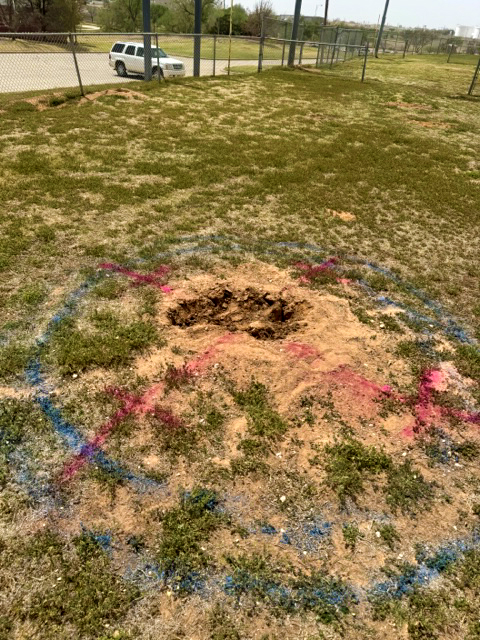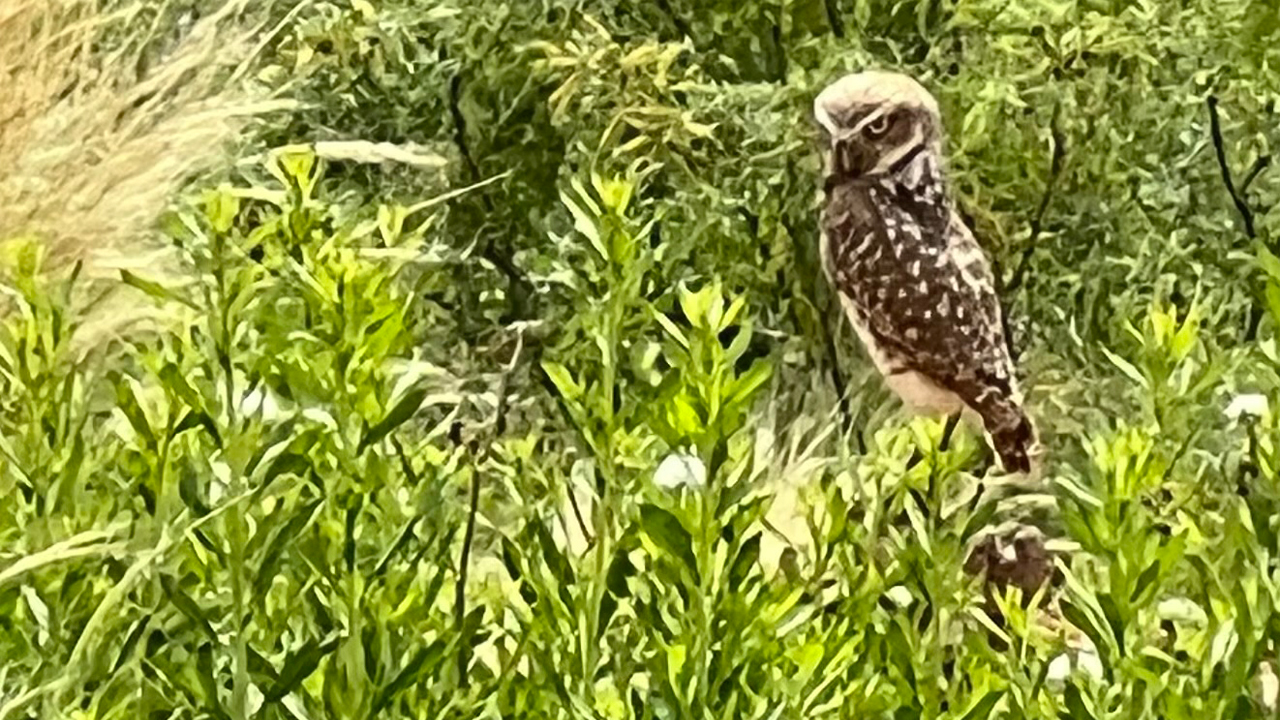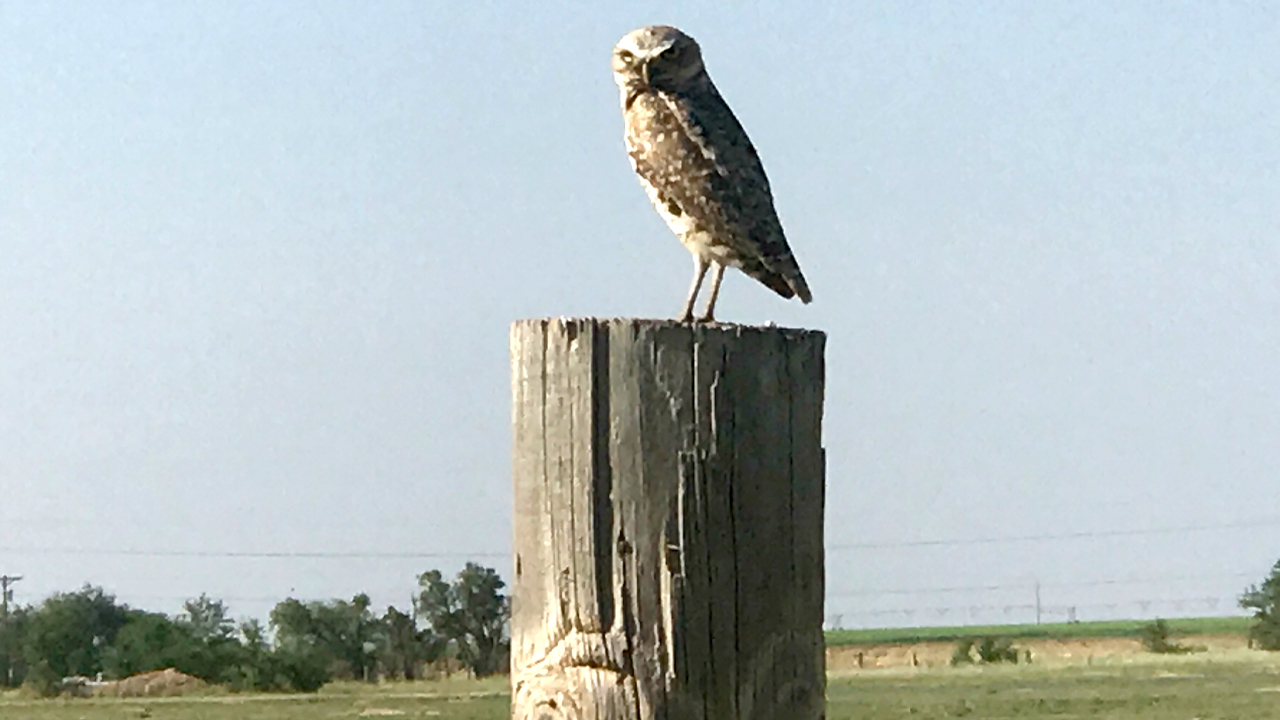Burrowing owl, East Lubbock County. Photo by Terry Greenberg.
Federal officials gave Lubbock a warning in April about killing prairie dogs in the Canyon Lake System, that stretches from Berl Huffman Athletic Complex to Mae Simmons Park and beyond.
Killing prairie dogs is not the problem but instead it’s killing a protected species, the burrowing owl, which uses prairie dog burrows for nesting.
In April, a federal game warden met with city officials and instead of pursuing enforcement against Lubbock, he asked Duane Lucia, a biologist with the U.S. Fish and Wildlife Service, to give written guidance – which Lucia did in an email to the city.
Lucia described it as a “mulligan” for the city and paraphrased his interaction with the game warden, saying, “His boss said, ‘Hey, let’s see if we can get them in compliance and keep them in compliance without dropping the hammer.’”
That “hammer” for individuals is either a fine or prison time. For organizations, it’s a fine of up to $10,000 or $100,000 depending on the violation according to epa.gov.
Lucia’s email also supports a partnership between the city and the Llano Estacado Audubon Society – which the Audubon Society said has not materialized.
“It’ll be interesting to see how the city responds in the future,” Lucia told LubbockLights.com. “If they act up, the next time the federal game warden is going to come down on them because that’s what he said.”
Colby VanGundy, Lubbock’s director of parks and recreation, acknowledged the meeting.
“We met with [Texas] Parks and Wildlife, and we met with some people from U.S. Fish and [Wildlife Service] and just talked through the processes of what we can do,” VanGundy said.
This is not the only issue on the table. The Audubon Society raised other concerns beyond prairie dogs and burrowing owls – including the city’s method of removing trees and removing cattails in the Canyon Lakes.
Audubon and the city have different opinions on what needs to happen next, and they don’t even agree on what recently happened when the city hired contractors to work in the Canyon Lakes System.
‘They were gassed anyway’
The Audubon Society tried to work with the city before the killing of prairie dogs earlier this year – spray-painting a mark around burrows which contained the protected owls. But the marked burrows were targeted anyway, said Audubon member Rob Lee.

“We sent pictures. We sent descriptions. We told them how they were marked. They were gassed anyway. There was a lot of really upset people because this is like killing their pets to some people. And so, any wrath that was generated by that was earned,” Lee said.
There was no definitive evidence burrowing owls died, because federal officials stopped short of a full investigation, Lee said.
Lee is retired from U.S. Fish and Wildlife. He urged his former employer to have the city turn to the Audubon Society rather than turn directly to enforcement.
“I don’t want to be like a grumpy old man telling you get off my lawn,” Lee told LubbockLights.com.
Lucia’s email – obtained by LubbockLights.com – contained a stern warning of how serious the situation was.
“This email was prepared for LP&R [Lubbock Parks and Recreation], in response to actions they implemented that could have caused them to violate the Migratory Bird Treaty Act, while they were trying to reduce prairie dog populations,” the email said.
Lucia said roughly 20 years ago, when he worked for Texas Parks and Wildlife, he wrote an email to the city raising similar concerns about not violating the law when killing prairie dogs.
Cattails and trees
Lee’s goal is to get more than just a better prairie dog plan, but also convince Lubbock to do better with other conservation projects.
Lee mentioned a $630,000 city contract for tree and brush removal. He also mentioned two contracts totaling more than $800,000 for 1.3 million square feet of cattail removal. Both projects were paid from American Rescue Plan Act money.
The tree and brush removal was environmentally damaging, Lee said.

“They were scraping the ground clear of vegetation,” Lee said. “The contract was to basically cut anything down that was less than 3 inches in diameter from the shoreline to 30 feet out – and to trim the branches on any existing trees – and take down what the contract said was nuisance vegetation.”
VanGundy said that’s not right, saying there was no scraping.
Cattails have been selectively removed from the lake system in areas where it won’t make erosion worse, he said, adding that’s done exclusively with herbicides. He’s critical of using a backhoe to scrape the shoreline.
“If you go through there and try to pull them out with a backhoe or whatnot, you run a big risk of reseeding,” VanGundy said.
That sort of thing was done, he said, before he became director in 2020.
“About a year before I got here, over … by Mackenzie south of Joyland, that area was done with a backhoe – coming in and just taking all of the cattails out and basically throwing them away. But what happened is when you did that, they reseeded and they came back even stronger,” VanGundy said.
As for the tree and brush removal, VanGundy said one reason was to restore sight lines. It allows police officers to see if anyone is illegally camping in the Canyon Lakes overnight.
While VanGundy said scraping did not happen recently, Lee said it did and provided photos of the aftermath.
“I was concerned because it didn’t appear that there was a consideration for the value of the natural resources that exist,” Lee said. “What surprised me was the scraping of the soil was beyond the details of that contract.”
Lee claimed the work just caused more erosion which only encouraged more cattails. Lee and VanGundy agree cattails are considered an invasive species. Left unchecked, they cause problems for fish and wildlife in and around the lake.
“I didn’t understand the idea of destroying the soil profile on the shoreline, because that’s what provides stability and prevents erosion. And it’s where a lot of the natural vegetation already existed,” Lee said.
Feds encouraged partnership not adversary
Lucia’s email to the city said, “As I mentioned in the meeting that we had at the TPWD Law Enforcement Office, the Audubon Society should be considered an asset instead of an adversary. They could continue to help you mark and monitor burrows for owls.”
LubbockLights.com asked VanGundy about partnering with Audubon for prairie dogs and other conservation projects.
“We have multiple, multiple user groups and those are a wide range from Little League associations to … school systems that utilize the park,” VanGundy said. “The Audubon association has helped us out in a lot of ways.”
He mentioned the planting of Cottonwood trees around neighborhood playa lakes, as one example. But he did not mention prairie dog management together with Audubon.
Lee said, “We have not had anybody reach out to us to help with developing that plan. … Personally, I can help the city develop a plan that will provide a little bit better PR.”
“The main thing I see is we don’t have a good plan to manage natural resources. And that’s what I hope that we could help with the Audubon Society,” Lee said.
The city needs a resource assessment – not nearly as complicated or expensive as an environmental impact study, Lee said.

“What I’m suggesting is just an inventory … of what we have,” Lee said.
And it can be done at little or no cost to the city, Lee claimed.
“We don’t seem to be able to establish those working relationships that would be beneficial. Now would be a good time for that to happen,” Lee said.
VanGundy pointed to his department’s current masterplan which includes an assessment.
“We have our master plan that lays out the Canyon Lake system. We have an inventory of every one of our physical resources there,” VanGundy said.
It’s not 100 percent inventory of everything, he said. His staff continues adding to the plan park-by-park, VanGundy said.
Lee said, “A lot of people in Audubon, like myself and others, have had careers in managing natural resources. … We’re not asking for anything other than a chance to help.”
City procedure to protect the owls
VanGundy, Lee and Lucia all agree the city needs to manage prairie dog populations in certain areas.
“We have one of the best cross-country courses in the state of Texas and I’ve ran on this course when I was in high school 25 years ago,” VanGundy said of the course in Mae Simmons Park. “We got prairie dogs going through it, and it’s a very dangerous spot for runners.”
The danger includes stepping in a hole and breaking a leg. It’s the same danger for kids playing soccer at the Burl Huffman Complex off North Loop 289.
“It’ll break a leg. I mean, it’s not a case where it’s always just, ‘I fell in. No big deal,’” VanGundy said.
Lee agreed, saying, “That’s a big concern, and it’s a valid concern.”

VanGundy spoke of the need for a balanced approach, saying, “We understand the prairie dog is native to this area, and … we want to make sure that we celebrate that.”
VanGundy described the city’s procedure after talking to federal and state officials back in April.
“During the migration period [for the burrowing owls], we will do a three-day observation period where we go out and we have staff that look at the area,” VanGundy said. “We got a camera system that puts GPS coordinates wherever we take that picture.”
Another part of the plan is: “Only take care of areas during that migration period that are sports-field related,” he said.
Proposed project
Lee gave an example of where he thinks the Audubon Society can prove its value.
“There’s 217 acres by the old railroad trestle beyond Lake 6. The city has mentioned in the past that it’s suitable for reintroducing a native shortgrass prairie,” Lee said.
Lee said he’s already talked to the U.S. Department of Agriculture and converting the property can be done for about $200 acre.
“We could make a real demonstration area of how shortgrass prairie could be restored, and I would really like Audubon to be part of that project in the future,” he said.
VanGundy said, “We’re going to be developing a trail system.”
The plan is to hear from multiple groups, and he’s in talks with the Texas Parks and Wildlife Department on a viewing area to see how a natural playa truly works.
“This seems to be a perfect area,” VanGundy said.
Comment, react or share on our Facebook post.


 Facebook
Facebook